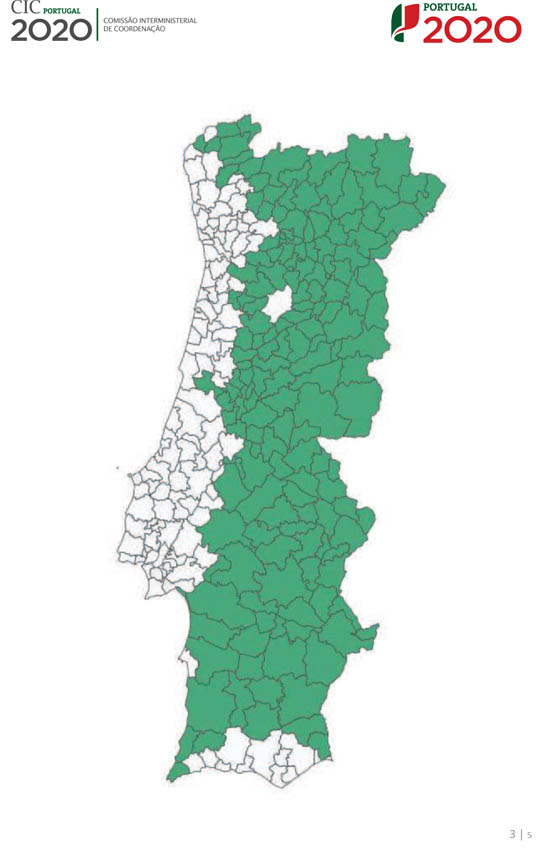Low density areas (ABD) are registered in the National Territorial Cohesion Program. It contains 165 complete municipalities and another 20 municipalities with just a few parishes. There are entire NUTS II and NUTS III regions (intermunicipal communities) completely included in this catalogue.
The problem has been known for many decades. We live in a small but dual country, the coast and the great interior, a country with two large metropolitan areas and their respective adjacent arcs that make the transition to the most remote municipalities in the interior.
In the end, a country without a backbone, at the same time too centralist and too localist, a melancholic country that for decades was complacent with a lot of political, institutional and associative incompetence.
There is, however, no determinism in this being the case. The intelligent specialization or smartification of territories translates into the intelligent application of technological and digital devices, it can reverse the logic of things and transform a vicious circle into a virtuous circle of development if certain conditions are met. Let's see what these conditions are, almost all of them structural in nature.
Firstly, scale, or, if we want, multi-scalarity: low-density municipalities need to be part of networks of towns or cities or, alternatively, be members of a city-region, a trajectory that inter-municipal communities (CIM ) will do so progressively; This insertion into network territories increases the endowment of common resources, the muscle of the actor-network and the production of joint goods.
Secondly, ABDs need to be equipped with a digital infrastructure with high connectivity, 4G and 5G: this quality coverage will allow not only to generate greater internal and external interactivity but also to produce more differentiated content and, therefore, more easily attract human capital from different origins and also more differentiated. See, by the way, the national strategy for connectivity and the priority given to so-called white areas.
Thirdly, the ABDs need a center of rationality and territorial intelligence: it is about moving up the value chain of regional programming and planning in order to trigger the production of data and content in sufficient quantity and quality capable of making the economy of made-in platforms, but also of carrying out a vast program of technological and digital literacy; Polytechnic institutes and business centers can be the basis of these operations, but also in secondary education, a school of arts and technologies should be created in each CIM to increase technological and digital literacy and expand the regional recruitment base.

Fourthly, ABD urgently need more intelligent communities, with more emotional intelligence and an effective desire for collaboration: these communities need strong incentives for proximity associations and, also, for more virtual-based associations; School groups, business associations, producer clubs are a good starting point, but other initiatives are possible, for example, within the framework of professional associations, unions, cultural associations and active aging programs, in multiple forms of telecare and outpatient network.
Fifthly, ABD, the string of pearls and the production of innovative projects and content: in the knowledge society, development problems are problems of lack of knowledge; heritage and landscape, science and technology, arts and culture, form a virtuous triangle, a string of pearls from which the projects, contents and distinctive signs of ABD germinate; research centers, master's and doctoral students, interns and guest researchers, form a privileged group that, well structured and guided, can support the economy of multi-location platforms in the production of data and content.
Sixthly, ABD and the stimulation of human capital flows: we need to create the conditions to generate a regular and growing flow of population, perhaps later, who knows, this flow could be converted into a stock of residents; the residential economy (senior citizens), migrant workers, occasional tourists, digital nomads, artistic, scientific and cultural residencies, holiday and work camps, intermittent workers in the creative industries mobilized by a growing number of events, It is as a whole and through external economies and complementarity effects that trigger a strong stimulation to attract and retain more and more human capital.
Seventhly, the ABDs urgently need to create a sustained starting up movement: one of the intelligent communities that needs to be created in the intermunicipal community concerns the associations of young entrepreneurs that can be stimulated through the creation of a regional technology hub with multiple purposes, with coworking spaces, artistic and scientific residencies, start-up incubators, arts and crafts workshops, training academies, internship centers, etc.
Eighthly, ABDs are very sensitive to multi-level governance and their territorial cohesion policies: due to their special vulnerability, ABDs are net beneficiaries of many investment incentives based on differentiated programs of European, national, regional and cross-border origin; the biggest problem lies in the territorial consistency of all these stimuli which, in our case, often come up against the centralism of programs and the labyrinth of procedures; The actor-network has the mission of providing coherence to all these territorial policy aids.
Ninthly, ABDs are very sensitive to the green economy and circular economy: due to their special vulnerability to climate change and the energy and agroecological transition, ABDs are direct beneficiaries and can be very creative when it comes to managing the green economy – the articulation between green infrastructures (IV) and ecosystem services (ES) – as well as in many innovative circular economy projects and respective value chains.
Tenthly, from territorial branding to actor-network and territorial curation: ABD, due to their special fragility, must pay particular attention to the culture of the territory and its symbolic representation; In this sense, three aspects deserve to be highlighted: the territorial brand and its external image, the formation of a representative mission structure called actor-network, the curation of the territory as a project of interconnection of all the main territorial assets.
Final grade
We are living through an extraordinary decade, of major transitions, full of contradictory effects, which can be particularly aggressive in low-density areas, as is already the case, for example, with severe droughts and forest fires.
Intelligent specialization, or smartification of ABD, through the information, knowledge and creativity it mobilizes, can reveal to us extraordinary facets of these territories, their assets, distinctive signs, value chains and micro-narratives, who knows, a surprising new world to rediscover and reinvent.



















Comments